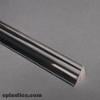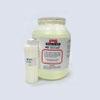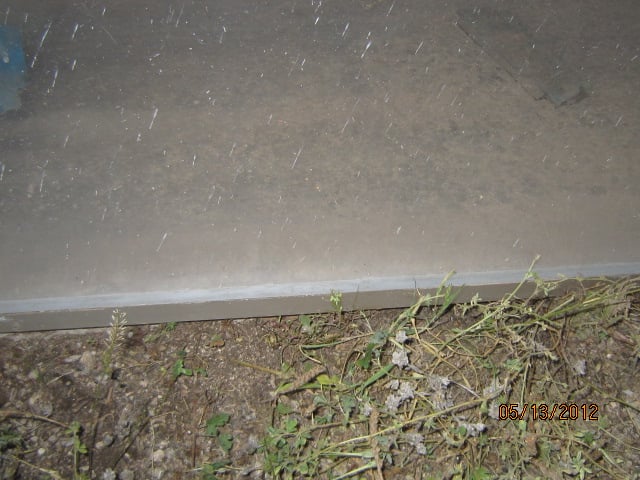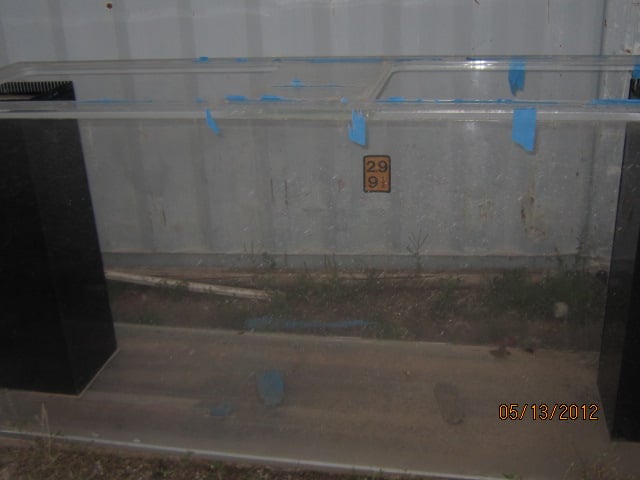That's my point Corey......If I'm understanding correctly I don't have any issue with an 8' tank, but 42" tall is way thin for 1" material.....The other thing is the radius is a bit small in the corners for my liking to distribute the stress......
A lot comes into play when deciding material thickness.....Length of panel, but height is the biggest considering factor........
Jeff I hope that's your name......I will tell you how to do it, but there is no guarantee at all on my part......As I mentioned earlier you'll want to ensure you can get entirely underneath that front panel from corner to corner.......Perferrably if you can slide straight pins underneath the bottom and front panel would be ideal IMO.......What you need to do and check for is you don't want any residue or crap inside that joint at all.......Your going to need to take an air compressor and blow gun and blow that seam out....Make sure it's completely clean and dry..........If there is any old residual solvent or such along the entire seam or any particular spot your chances of a good joint are poor.......
Here goes.........
You'll want to get yourself a handful of twisty ties and strip the paper off of them.......What you'll want to do is every 6" or so slide a twisty tie halfway into the joint....meaning you'll want the twisty in roughly a tad more than 1/2".......What you'll also need to ensure is that you have a almost perfectly level area/table your going to work on.......What you will do everywhere you have a twisty tie slid into the joint you will need a wood shim.....I prefer the composite shims over the cheapo wood shims. What your going to do is slide the shims under neath the tank......What you are trying to do is level everything out and create even drag on all the little twisty ties......Again this is something your not going to get the feel for over night.....This techinque takes a bit of practice.....(a lot of practice). You want to ensure that all the pins (twisty ties) have about the same drag on them.......
What happens next......(again I advise to practice first cause you have 1 shot), no do overs!!!! You'll start from 1 end and start apply your solvent.......Don't force the needle applicator under the panel......Don't squeeze the bottle. The solvent should run and wick (seep under the panel)......You should see the entire joint become wet.......Again practice with working the bottle and how fast to move it.......You'll want to wet the entire joint and it should be completely wet, and shouldn't consume a lot of solvent......Waiting roughly 30 seconds and that has a lot of variables depending on temp and humidity, but as soon as you get the entire joint wet out, you need to go back and start pulling the pins (twisty ties) out of the joint.....What is happening and the reason behind the pins (twisty ties) is your allowing the solvent to actually attack; melt the acrylic a bit, so you get a good bite......As you pull the pins you'll see a bit of solvent ooze or push out of the joint.......Again you don't have a lot of time to play with, so again I stress practice; a lot of practice with the procedure......Another handy tip I have for you is to keep a pair of needle nose pliers in your pocket.....I used pins, and had a head come off and the weight of the acrylic will actually start to push the pin into the material....What this can do if your not prepared is create a void in your seam for a possible leak, so keep the handy and be prepared......
Again with all the pins pulled you'll want to go back to your shims and just snug them up even along the entire seam.....Snug to much and you'll see the joint push solvent or become dry.....You want even pressure along the entire joint.......Allow the seam to setup 24hrs before handling.......
I would suggest probably the easiest solvent would be the WeldOn 4......I would try to do the glue job on a cool day or coolest part of the day....With your location and Corey can attest humidity is a big enemy.......I can't remember and way to technical, but there is a way to slow the reaction down a bit, but not entirely sure of the components to do it........
Once you get that setup and let it set for 24hrs, I'd probably use the triangle gusset as I'll call it.....Again this is not guaranteed........Here's is the gussett, I'd recommend using on the patch job......

Large Triangular Rod 1 x 1 x 1.375 Base x 6ft long
You'll need (2) of them since the tank is 8' long......They are $16.19 a piece...........
To lay this gussett as I'm calling it you can either use WeldOn 4 again......This step or process will vary.....Depending how good you glue or confident you feel you can opt to use WeldOn 40 for laying the gussett.....Personally I'd feel a bit better with using the WeldOn 40, but it offers no real strength value over the WeldOn 4 unless it's annealed which you can't do.........
With that being said the reason I like the WeldOn 40 for this application, you can almost eliminate your chances of any micro bubbles or pin heads if you work carefully........What you would do then IMO would be to set the tank on a 45 degree angle so you can pour a fillet joint of WeldOn 40 in the seam.......You don't want to use a lot of this product as well, and it does generate quite a bit of heat so be ware!!!!!! But with pouring it at a 45 degree fillet, you would then take the triangle gussett and sit down into the poured fillett, and press it down into the solvent which in turn would completely cover all sides of the triangle piece.....This is why I say don't use a lot of solvent, because when you press it down into place the solvent will spread and you don't want it oozing all over the place..........

This is the WeldOn 40 and is a 2 part mix....Sort of like an epoxy mix.......It's expensive and it runs $155.00 for the kit.....






